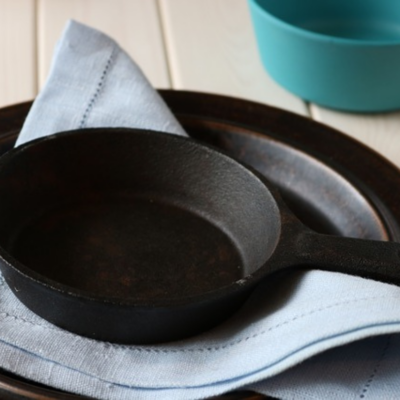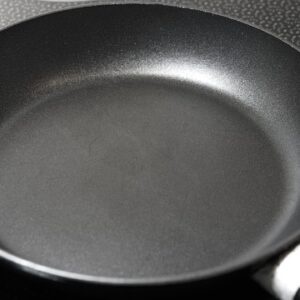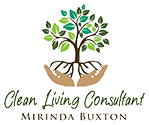Safer Solutions for Your Cookware

*This post contains affiliate links. That means that if you make a purchase after clicking on a link I may earn a small commission at no extra cost to you.
It never occurred to me, before becoming sick in 2016, that what I put on my skin could contribute to illness. It also never occurred to me that the healthy foods I was eating could be absorbing toxic ingredients from my cookware. Some of the same toxins found in my blood test are found in our everyday cookware, such as polytetrafluoroethylene (PTFE), Perfluorooctanoic acid (PFOA), Perfluorinated chemicals (PFAS), Aluminum, Copper, Cadmium, Chromium, Nickel, and Lead. So I switched to safer cookware, and today I am delving deeper into the subject for you and me. Read on to learn more about the currently popular cookware types, what I recommend using, phasing out, and tossing out all together.
Tough Talk About Teflon

Let’s talk about non-stick cookware – otherwise known as Teflon.
You may have heard that PFOA, PTFE, and PFAS are harmful to our health. Up until 2015, Teflon cookware was made using a chemical called perfluorooctanoic acid, or PFOA. It is a carcinogen, hormone disruptor, and reproductive toxin. Once it enters the environment, it does not leave. Think of what this means for our drinking water, seafood, and farmland soils! Further health studies on PFOA indicate that people exposed to the chemical are more at risk for the following health concerns:
- Thyroid Disease
- High cholesterol levels
- Health issues in children and babies
- Bladder, kidney, and testicular cancer
- Liver damage and disease
- Blood pressure concerns
- Colitis
Furthermore, numerous studies on PFOS and PFOA on humans and animals have shown a wide range of possible health, including decreased fertility among women, decreased sperm count and penis size, lowered birth weight, cancer, and – among animals studied – death.
A study funded by DuPont (the company that created Teflon non-stick coating) as part of a legal settlement with residents living near one of its Teflon facilities found that PFOA was linked to six disease outcomes: kidney cancer, testicular cancer, thyroid disease, ulcerative colitis, high cholesterol, and pregnancy-induced hypertension.
Though Teflon coated pans no longer use PFOA, they don’t just show up in non-stick cookware; they’re also used to make products in all areas of life: waterproof jackets, food packaging, stain removers, and personal care products like lipstick, to name a few.
When Teflon, even without the PFOA, is heated to high temperatures, the chemicals can enter the food being cooked. PTFE currently still in non-stick pans is a known toxin to birds, so current Teflon products (including self-cleaning ovens) include a warning to remove any birds from the room when heated. Exposure to Teflon fumes can result in flu-like symptoms in humans (metal or polymer fume fever).
While it’s believed that PFOA post-2015 is only present in Teflon products in such small amounts that it poses no risk to humans, PFOAs, as I said, are also found in many other everyday things like our personal care products https://www.theguardian.com/us-news/2019/may/23/pfas-everyday-products-toxics-guide. So it is best to limit your exposure wherever possible.
Teflon is still made with PTFE, and the jury is out on that. So definitely do not use any non-stick pans bought before 2015 and consider switching from non-stick coated pans to alternative cookware. I do not trust non-stick coated pans, so they are out for me.
But what should we use?
NEVER
The following should never be used when striving for safer cookware.
Aluminum is on my NEVER List for cookware. A neurotoxic metal linked to several central nervous system diseases, including Alzheimer’s and ALS. Though aluminum cookware is usually coated, the coating is prone to chipping, releasing the toxic metal into your food.
Copper is also on my NEVER List. I know copper pots and pans look pretty. And it seems like copper in your food would be beneficial. The kind of copper in your cookware is not the same as in your vitamins, and your body does not utilize it in the same way. Copper balance is crucial to our health and very easy to unbalance. An excess amount of it in the body can lead to heavy metal poisoning. When copper cookware isn’t coated, it can release copper when cooking acidic foods. And when it’s coated, the coating often contains nickel, which is another toxic element.
Phase Out/Recycle
The following should phased out/recycled when striving for safer cookware.
So what about the “GreenPan” ceramic coated cookware? GreenPan is on my phase-out list. When I became sick in 2016 and switched every toxic item in my house, a health coach recommended the GreenPan brand ceramic coated cookware. I read the label and what I could on it at the time. It says right on the label Free of PFAS, PFOA, LEAD & Cadmium. Many still recommend it as a healthy cooking alternative to Teflon, and it is better than Teflon. But the soft ceramic coating isn’t the most durable and starts chipping after several months of everyday use. It also “burns” off in high heat, which my son, who likes to cook fast and high, found out quickly. When used at high heat or scratched, the coating and underneath will end up in your food and then in your body.
As I dug further on the GreenPan brand specifically, I found it contains nanoparticles and other unknowns. In my research on skincare and sunblock products, nanoparticles are a NO for me (Toxic Beauty). There is currently a lawsuit brought about by a consumer who, like me, did some investigating. In her case, she states, “Thermolon coating on the products contain known toxins such as silane, aluminum oxide, tetraethoxysilane, methyltrimethoxysilane, and potassium titanate.” Here is a review of green pan.
Safe With Considerations
The following are Safer Cookware options with Caveats.
You are probably thinking like I was, “What’s a girl to do, since I know cooking on a stick over a fire has its drawbacks too?” Here’s where it gets tricky, don’t just switch to “safe” materials without checking each out based on some critical considerations I have found with a little digging. We all probably have some safe cookware and bakeware already: stainless steel from a reputable manufacturer, non-coated cast iron, glass, and uncoated stoneware. As we learn more and do better, let’s consider a few things while using them and make sure to rotate them.
Cast Iron has been around for thousands of years, but scientists have only recently been studying the ramifications of our cookware choices. I have learned that the iron from cast iron cookware is not the same type of iron we take in a vitamin or get through our food. And some of us, depending on our family’s current iron levels, might not need extra iron. The extra iron could potentially cause iron overload. Let’s mix up our cast iron with other safe cookware. When selecting your cast iron, make sure it is not coated with anything ahead of time unless you are sure the manufacturer can supply all the ingredients in the coating. I bought my cast iron uncoated and coated it myself with flax oil. See the how-to HERE. Also; please make sure you purchase from a credible manufacturer. So far, Lodge has been mentioned the most in my research and the brand I own Lodge Cast Iron Another recommended brand is Finex USA .
Glass: You would think clear glass would be safe always, but not so. Canada and the U.S.A. now have production standards around glass. However, older glass products did not have to comply with these regulations as they were manufactured before these regulations came into being. Unfortunately, this means that there are many glass baking and serving dishes out there that do not comply with today’s stricter standards. I know that I have older glassware that I have inherited, which I will not use to bake or serve. Lead Safe Mama has been checking glass piece by piece and has recommendations here on what to use.
Stainless steel pots and pans are among the most popular forms of cookware in America, but they are also formed from a compound that can leach chromium, lead, nickel, and iron into the prepared food in them. Most leaching occurs when you first use your stainless steel pots and pans. The highest leaching usually occurs in the first ten uses. To reduce levels, boil water in new steel cookware a few times and discard it before using it for cooking. Tomato-based dishes (all acidic foods) will also cause stainless steel to release more chromium into the food. It is estimated that a safe daily human intake of chromium is between 50 to 200 mg a day. Eating just one meal prepared in stainless steel cookware may cause a person to ingest approximately 45 mg of chromium. For acidic dishes like tomato-based ones, I use glass cookware specifically for the cooktop and oven.
With stainless steel, the manufacturer is essential (you get what you pay for) and ask if they do leach tests. Lead Safe Mama has pan she recommends here. My current stainless cookware is from 360 Cookware. I will be looking into it further, with all I’ve learned, but have been very pleased with the Wisconsin based company thus far. I also have and use Breville stainless steel cookware and have been happy with it, but will do more research given my new information. Whatever stainless steel company you choose, make sure it is quality and not scratched. Once it becomes scratched, it can leach lead, nickel, and iron, in addition to the chromium mentioned.
Unglazed Stoneware from Pampered Chef is a favorite of mine for baking. I do not see any negatives on the unglazed Pampered Chef stoneware. Oddly I didn’t see very many recommendations for it either. Most of the suggestions I found were from people using affiliate links, which I always research anyway. While we are on the topic, I have no affiliation with any of these companies, including Pampered Chef. If you do not have a Pampered Chef consultant, I know a few. Reach out to me and I will connect you.
Safe
Safe and what I will be trying after all these Considerations
After all these hours of research and questioning what I thought was already safe in my kitchen, I’ve decided that from here on out I will only purchase 100% ceramic cookware and unglazed stoneware for cooking and baking.
Most 100% ceramic cookware contains no metals like lead or cadmium, and several brands mention their glazes are made with non-toxic inorganic minerals and oxides. To be double-sure of this, look to see if the brand you’re interested in passes California Prop 65 standards.
Another great thing about ceramic cookware is that it cooks very evenly and is extremely durable, even under high heat. I have been in contact with Xtrema 100% ceramic cookware and have reviewed their ingredients. I spoke with a representative of the company and feel comfortable purchasing from them. I will let you know how it is cooking on them soon.
Image from Xtrema.com
Summary
In summary, do not use any non-stick pans bought before 2015. I can write another blog post on what to do with them instead of throwing them in the landfill where they will leach into our soil and water. Phase-out all non-stick pans, even the ones with the ceramic coating like GreenPan, as soon as they become compromised in any way. Check your stainless steel pans for scratches or pitting and recycle if they are. Consider when your glass was made, and consider a possible lead test if you are not sure. You can cut down on leaching by cooking acidic foods in safe glass cookware when possible or 100% ceramic cookware. Make sure your cast iron is non-coated and season it yourself safely. Rotate all your cookware! Thank you for reading about safer cookware solutions. I’m here to answer any additional questions you have.
-Mirinda
My Research Sources:
https://www.mamavation.com/home/healthy-home/cookware-bakeware-investigation-nontoxic-safe-brands.html https://tamararubin.com/2018/09/asktamara-do-you-recommend-corning-visionware/
https://www.theguardian.com/us-news/2019/may/23/pfas-everyday-products-toxics-guide
https://blog.paleohacks.com/toxins-in-cookware/#
https://www.nontoxicliving.tips/blog/safest-pots-and-pans-to-cook-with https://sophia-gushee.mykajabi.com/blog/ceramic-coated-cookware-vs-teflon https://mindfulmomma.com/non-toxic-cookware/ https://gonewmommy.com/2018/01/16/non-toxic-cookware/ https://lindsaydahl.com/non-toxic-non-stick-pans/?fbclid=IwAR1PgBXJ6cuOLHsffjWNRZTrFFq0GBQuKV2yJUS3mMn2iMNVbHlIpF7hers https://wellnessmama.com/5148/safest-cookware-options/ https://wellnessmama.com/?s=cookware https://wellnessmama.com/367774/ceramic-cookware/ https://www.stonefryingpans.com/non-stick-frying-pan-health-risks/

